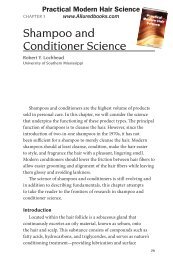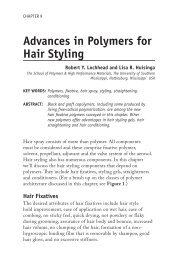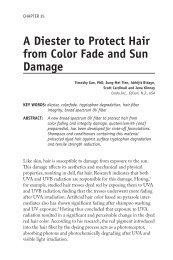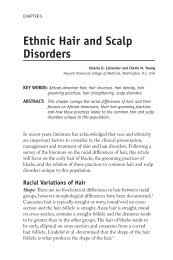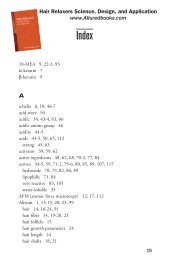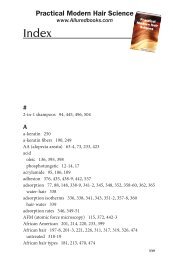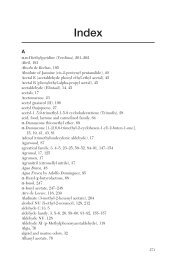In Vivo Quantitative Evaluation of Gloss - Allured Books
In Vivo Quantitative Evaluation of Gloss - Allured Books
In Vivo Quantitative Evaluation of Gloss - Allured Books
You also want an ePaper? Increase the reach of your titles
YUMPU automatically turns print PDFs into web optimized ePapers that Google loves.
Chapter 51<br />
<strong>In</strong> <strong>Vivo</strong> <strong>Quantitative</strong><br />
<strong>Evaluation</strong> <strong>of</strong> <strong>Gloss</strong><br />
A real time polarization analysis technique is described that<br />
differentiates components <strong>of</strong> scattered light in video images and<br />
enables in vivo quantitative evaluation <strong>of</strong> gloss from hair and<br />
skin during quality control and claims substantiation.<br />
key words: <strong>Gloss</strong>, shine, skin, hair, light scattering,<br />
polarization, imaging<br />
Cosmetic manufacturers need to quantify the visual appearance <strong>of</strong> their products<br />
objectively and accurately to study skin and hair, to improve the performance,<br />
quality and the reproducibility <strong>of</strong> cosmetic products, and to substantiate their claims.<br />
<strong>In</strong> vivo non-contact testing provides the most meaningful results since it is carried<br />
out in realistic conditions directly on a model. For this chapter, in vivo gloss measurements<br />
were conducted on commercially available hair and skin products.<br />
Color and <strong>Gloss</strong><br />
Color and gloss are two important parameters that define the visual appearance<br />
<strong>of</strong> an object. To simply explain the physics <strong>of</strong> the light-scattering phenomena, let’s<br />
consider the case <strong>of</strong> a planar object illuminated by an incident light coming from<br />
one direction (see Figure 51.1). The outgoing scattered light can be divided into<br />
different categories. 1-3 Figure 51.1.<br />
495
496<br />
<strong>In</strong> Vi v o Qu a n t i t a t i v e Ev a l u a t i o n o f Gl o s s<br />
Be g in n in g Co s m e t i c Ch e m i s t r y<br />
Mirror-like reflected light or specular reflection: A portion <strong>of</strong> light is<br />
optically reflected by the surface <strong>of</strong> the object at a symmetrical angle (mirror-like<br />
reflection at specular angle) just like a bouncing ball. Specular light does not usually<br />
penetrate the object, so in most cases it does not carry any information related to<br />
the color pigment. Thus, the color <strong>of</strong> the specular light is related to the color <strong>of</strong> the<br />
illumination. <strong>In</strong>deed, one can easily observe a white reflection when looking at an<br />
object from the specular angle. Artists call it a highlight, 3 to scientists it’s a specular<br />
reflection or surface scattering, and cosmeticians term it gloss, shine or luster.<br />
Volume scattering: A portion <strong>of</strong> light penetrates inside the object and is scattered/absorbed<br />
by the color pigments. The volume-scattered light that is not fully<br />
absorbed leaves the object carrying the color information <strong>of</strong> the pigments. <strong>In</strong>deed,<br />
when viewing an object from an angle other than the specular angle, one can observe<br />
the color <strong>of</strong> the object. Volume-scattered light is also called diffused light.<br />
Surface scattering: Finally, a portion <strong>of</strong> light is scattered at the surface <strong>of</strong> the<br />
object because <strong>of</strong> the presence <strong>of</strong> surface defects. The surface-scattered light carries<br />
the information <strong>of</strong> surface quality and surface defects. It is <strong>of</strong> particular importance<br />
for the analysis <strong>of</strong> metallic surfaces, when there is no volume-scattered light.<br />
Degrees <strong>of</strong> <strong>Gloss</strong>: Gd and Gd*<br />
Based on the above parameters, we can define two gloss degrees (abbreviated<br />
Gd and Gd*):<br />
• Gd, ranging from 0% (low gloss) to 100% (high gloss), is the percentage <strong>of</strong><br />
specular light in the total amount <strong>of</strong> reflected light.<br />
• Gd*, ranging from 0 (low gloss) to ∞ (high gloss), is the ratio <strong>of</strong> specular<br />
light divided by the volume-scattered light in the direction <strong>of</strong> observation.<br />
Gd* allows the classification <strong>of</strong> high gloss objects.<br />
Both Gd and Gd* cover a large range <strong>of</strong> glosses and allow the evaluation and<br />
classification <strong>of</strong> cosmetics products. Furthermore, because they take into account<br />
the total reflectivity <strong>of</strong> the object, they are correlated to the visual assessment carried<br />
out by the human eye. Dark objects, for example, appear glossier (because <strong>of</strong><br />
their low reflectivity) than light objects (high reflectivity).<br />
Operating Principle<br />
Our evaluation technique is based on differentiating and measuring the types<br />
<strong>of</strong> scattering events. Depending on its origin, the light scattered exhibits various<br />
polarization signatures. 1,2,4 Specular light, for example, has the property <strong>of</strong> preserving<br />
the original polarization state whereas diffused light is fully depolarized. We<br />
use an innovative real time polarization analysis 5,6 technique (see the Polarization<br />
Analysis sidebar) to quantify the scattering events described above.<br />
By using a polarimetric camera with a high polarization contrast parameter<br />
value (>100) at a fast video rate (15-30 frames/sec), one can now measure the<br />
following scattering parameters— 1,2,4 specular light, surface-scattered light, and<br />
volume-scattered light, all in black and white— or if needed, in the red, green<br />
and blue colorimetric space. Figure 51.2 presents three images delivered by this<br />
imaging system a .
497<br />
Be g in n in g Co s m e t i c Ch e m i s t r y Ch a p t e r 51<br />
Figure 51.2.<br />
Polarization Analysis<br />
Using a polarized illumination, specular and diffused components <strong>of</strong><br />
light can be retrieved by measuring parallel and crossed polarizations. This<br />
separation has already been used and explained in past literature for hair<br />
luster analysis. 7<br />
Thanks to recent advancements in electro-optics technology, a fast polarimetric<br />
video camera with a high polarization contrast (>100) was developed<br />
in order to perform real-time analysis. The polarization contrast is actually a<br />
parameter that quantifies how well the technique can break the scattered light<br />
into its components. The higher the polarization contrast <strong>of</strong> the system used,<br />
the better the analysis and the separation <strong>of</strong> the components. It is critical to<br />
use a high polarization contrast (>100) technique in order to well separate<br />
the components and carry out accurate gloss measurements.<br />
The classical image is the real image delivered by a usual camera. It presents<br />
both color and gloss information. It contains the information <strong>of</strong> totally reflected light<br />
and is the sum <strong>of</strong> the parallel polarization (P) and the crossed polarization (C).<br />
<strong>In</strong> the case <strong>of</strong> skin, the surface image does not provide any color information<br />
and is black and white. It shows the distribution <strong>of</strong> the surface scattered light on the<br />
complex shape <strong>of</strong> the face, highlighting the surface imperfections (pores, wrinkles).<br />
<strong>In</strong> addition, it extracts and displays the specularly reflected light. Mathematically,<br />
it is the exact difference between the P and the C image.<br />
The volume-scattering image presents no specular light and shows the diffused<br />
light and the true colors <strong>of</strong> the skin. It was calculated by multiplying by two the<br />
crossed polarization image C.<br />
Using the definitions previously given, the images are then processed and combined<br />
to provide accurate and consistent gloss values Gd and Gd* on areas <strong>of</strong> the<br />
object specifically chosen by the user. The primary innovation <strong>of</strong> this technique is<br />
that it allows for the gloss characterization <strong>of</strong> curved and highly textured surfaces<br />
which, until now, was not possible with classical gloss meters.
498<br />
<strong>In</strong> Vi v o Qu a n t i t a t i v e Ev a l u a t i o n o f Gl o s s<br />
Be g in n in g Co s m e t i c Ch e m i s t r y<br />
Experimentation<br />
The experimental set-up for gloss measurement includes: a polarimetric imaging<br />
sensor; a polarized illumination system; and a computer with s<strong>of</strong>tware dedicated<br />
to fast polarization image acquisition, processing and display <strong>of</strong> results (Figure<br />
51.3).<br />
Figure 51.3.<br />
The illumination can be based on fluorescent lights (cool white) or white Light<br />
Emitting Diodes (LEDs), which make it compact, cold and easily controllable. The<br />
s<strong>of</strong>tware was developed to provide calibration, acquisition <strong>of</strong> polarization images,<br />
gloss measurement, real-time analysis, display and recording <strong>of</strong> various images. A<br />
chin rest or a head rest is also used to control the position <strong>of</strong> the face for optimum<br />
repeatability.<br />
Results<br />
<strong>In</strong> vivo gloss measurement <strong>of</strong> foundation: Foundations presenting various<br />
levels <strong>of</strong> gloss were tested with the system. A Region <strong>of</strong> <strong>In</strong>terest (ROI) in the “T”<br />
area <strong>of</strong> the face was chosen for the measurement. The gloss degree was measured<br />
on each pixel in the entire ROI; then the average <strong>of</strong> all the values was calculated.<br />
Results <strong>of</strong> eight commercially available foundations are shown in Figure 51.4.<br />
The gloss results correlate to visual observation and confirm the matte/glossy<br />
nature <strong>of</strong> each foundation. The glosses ranged from 19% to 45% on the Gd scale,<br />
which demonstrates large differences between commercially available products.<br />
The accuracy <strong>of</strong> our measurement was better than 0.5 gloss unit on the Gd scale<br />
without using any additional time averaging with the video imaging sensor.<br />
Efficiency testing <strong>of</strong> hair product: We also quantified the evolution <strong>of</strong> hair<br />
shine in the following five different conditions: uncombed; combed; combed with a<br />
reference conditioner; combed with a shine improvement conditioner; and combed<br />
with a shine improvement conditioner plus a liquid polish. Since hair is a highly<br />
reflective object with low diffusion (Gd>70%), we chose to plot the results on a<br />
Gd* scale as shown in Figure 51.5.
499<br />
Be g in n in g Co s m e t i c Ch e m i s t r y Ch a p t e r 51<br />
Figure 51.4.<br />
Figure 51.5.<br />
The results show a large range <strong>of</strong> Gd* values depending on hair conditions and<br />
the products that were applied. Combing drastically increases the reflected light by<br />
50% and makes hair shinier. A classical conditioner increased the shine <strong>of</strong> combed<br />
hair by another 10% while a second conditioner, claiming to improve the shine,<br />
increased it by 40%. By adding a liquid polish, we could further increase the shine<br />
<strong>of</strong> combed hair by 60% reaching a Gd* value <strong>of</strong> 7.85. The total uncertainty <strong>of</strong> the<br />
measurement was 0.3 on the Gd* scale.<br />
The Gd* measurements obtained correlate to the visual assessment and depend<br />
on the hair color <strong>of</strong> the model. The present measurements were carried out on light<br />
brown hair. Higher values <strong>of</strong> Gd* as well as larger gloss effects due to the application<br />
<strong>of</strong> the products are expected in the case <strong>of</strong> dark brown or black hair.<br />
<strong>Gloss</strong> distribution: We calculated the <strong>Gloss</strong> Degree (percentage <strong>of</strong> specular light<br />
in the total amount <strong>of</strong> reflected light), pixel by pixel, in order to instantly represent<br />
the spatial distribution <strong>of</strong> the gloss <strong>of</strong> a complex 3D surface such as a human face<br />
using the formula Gd = (P – C)/(P+C). The color <strong>of</strong> the images <strong>of</strong> Figure 51.6 was<br />
encoded by the <strong>Gloss</strong> Degree using the color scale shown in each image. This “gloss<br />
mapping mode” allows the user to visualize immediately the gloss distribution and<br />
efficiently communicate the differences between two products. Figure 51.6 shows



